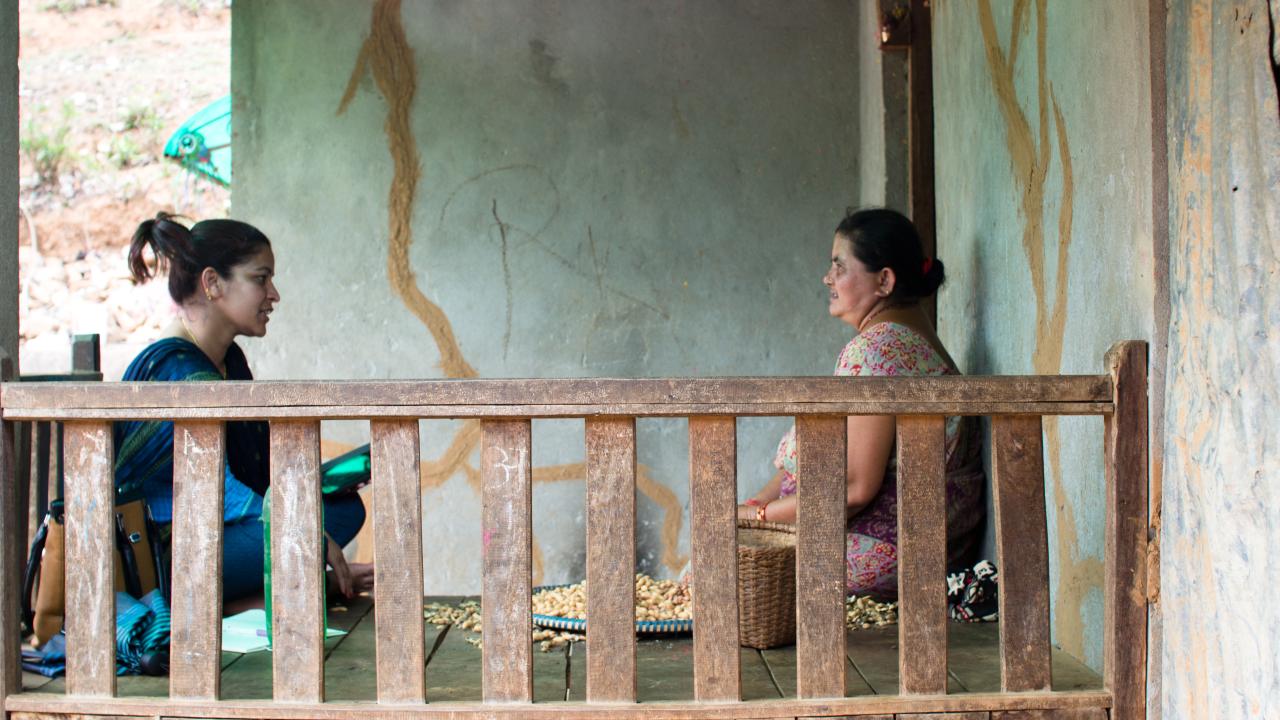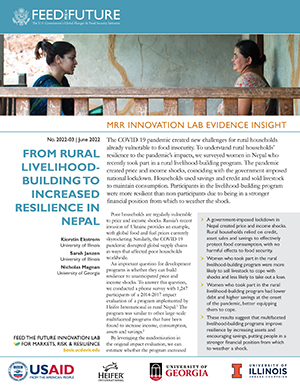
The COVID-19 pandemic created new challenges for rural households already vulnerable to food insecurity. To understand rural households’ resilience to the pandemic’s impacts, we surveyed women in Nepal who recently took part in a rural livelihood-building program. The pandemic created price and income shocks, coinciding with the government-imposed national lockdown. Households used savings and credit and sold livestock to maintain consumption. Participants in the livelihood-building program were more resilient than non-participants due to being in a stronger financial position from which to weather the shock.
Key Points
- A government-imposed lockdown in Nepal created price and income shocks. Rural households relied on credit, asset sales and savings to effectively protect food consumption, with no harmful effects to food security.
- Women who took part in the rural livelihood-building program were more likely to sell livestock to cope with shocks and less likely to take out a loan.
- Women who took part in the rural livelihood-building program had lower debt and higher savings at the onset of the pandemic, better equipping them to cope.
- These results suggest that multifaceted livelihood-building programs improve resilience by increasing assets and encouraging savings, putting people in a stronger financial position from which to weather a shock.
Poor households are regularly vulnerable to price and income shocks. Russia’s recent invasion of Ukraine provides an example, with global food and fuel prices currently skyrocketing. Similarly, the COVID-19 pandemic disrupted global supply chains in ways that affected poor households worldwide.
An important question for development programs is whether they can build resilience to unanticipated price and income shocks. To answer this question, we conducted a phone survey with 1,247 participants of a 2014-2017 impact evaluation of a program implemented by Heifer International in rural Nepal.[1] The program was similar to other large-scale multifaceted programs that have been found to increase income, consumption, assets and savings.[2]
By leveraging the randomization in the original impact evaluation, we can estimate whether the program increased resilience among women who participated. This research design makes it possible to attribute any differences in outcomes to the program itself.
COVID-19 Responses in Rural Nepal
On March 24, 2020, the Government of Nepal implemented a four-month national lockdown that prohibited domestic travel, closed the border and limited nonessential services.[3] The lockdown was strictly enforced in urban areas but less so in rural areas. Nonetheless, supply chain interruptions affected prices for food and other goods everywhere.
Slightly more than half of all survey respondents experienced at least one shock in the 18 months prior to the survey. The most common shocks were a decrease in income not coming from remittances (22%), serious illness (16%), increasing food prices (14%) and falling prices for their agricultural production (11%).
While illnesses and deaths related to COVID-19 were steady, decreases in income, increases in food prices and falling agricultural prices all spiked during lockdown before gradually recovering between October 2020 and March 2021 when COVID-19 cases reached new highs. This pattern suggests that the lockdown—not illness—was the primary cause of financial shocks.

Savings, Credit and Resilience
In spite of these shocks, less than 2 percent of all households reported changes in food consumption. The most common coping strategy was to use credit, which 26 percent of households did. Of all households who borrowed during the lockdown, 61 percent used it to buy food.
The percentage of respondents with any debt doubled from roughly one quarter of the total sample in October 2019 to more than half by March 2021. Average debt rose from $500 in October 2019 to $870 by March 2021, a 70-percent increase. While loans provided a way to cope, they were also expensive, with an average annual interest rate of 18 percent.
Women who took part in the livelihood-building program borrowed substantially less than non-participants. Before the pandemic, debt was $304 lower on average among participants compared to non-participants. While debt among participants doubled a year later, it was still $418 lower on average than non-participants. Women in the program were 9 percentage points less likely to use a loan to cope during the lockdown period.
Of all households with savings, 84 percent used savings to buy food. Roughly four out of every five women in the full sample had savings at any point, with an average balance of $262 over time. About 8 percent reported using savings to cope.
Women who took part in the livelihood-building program were 9 percentage points more likely to have savings before the pandemic than non-participants with a slight decline one year later. In each period, savings were $75-$78 higher for participants compared to the non-participant average of $193-$235. Program participants were equally as likely as non-participants to use savings to cope.
Participants were twice as likely to sell livestock during lockdown to cope compared to non-participants. This demonstrates how goats can be used as a buffer against shocks in this context, helping households maintain consumption even as income drops and prices rise.
Preparing for a Shock
Just as vulnerable rural households face difficult tradeoffs when responding to shocks, policymakers also face difficult tradeoffs when it comes to social protection. One common response is to provide cash, food aid or other forms of assistance, all of which protect against the worst possible outcomes.
However, government resources could improve resilience in advance of a shock. These results from Nepal suggest that multifaceted livelihood-building programs improve resilience to shocks by increasing assets, reducing debt and encouraging savings. The program in Nepal put women in a stronger financial position before the pandemic, which improved their long-term resilience.
[1] Janzen et al., 2020. “Report: Evaluation of the Welfare Impacts of a Livestock Transfer Program in Nepal.” MRR Innovation Lab.
[2] Banerjee et al. 2015. “A multifaceted program causes lasting progress for the very poor: Evidence from six countries. Science.
[3] Srivastava, N. et al. 2021. “Policy Responses to the COVID-19 Pandemic in Nepal. Technical Report 8.” IFPRI.
This report is made possible by the generous support of the American people through the United States Agency for International Development (USAID) cooperative agreement 7200AA19LE00004. The contents are the responsibility of the Feed the Future Innovation Lab for Markets, Risk and Resilience and do not necessarily reflect the views of USAID or the United States Government.
